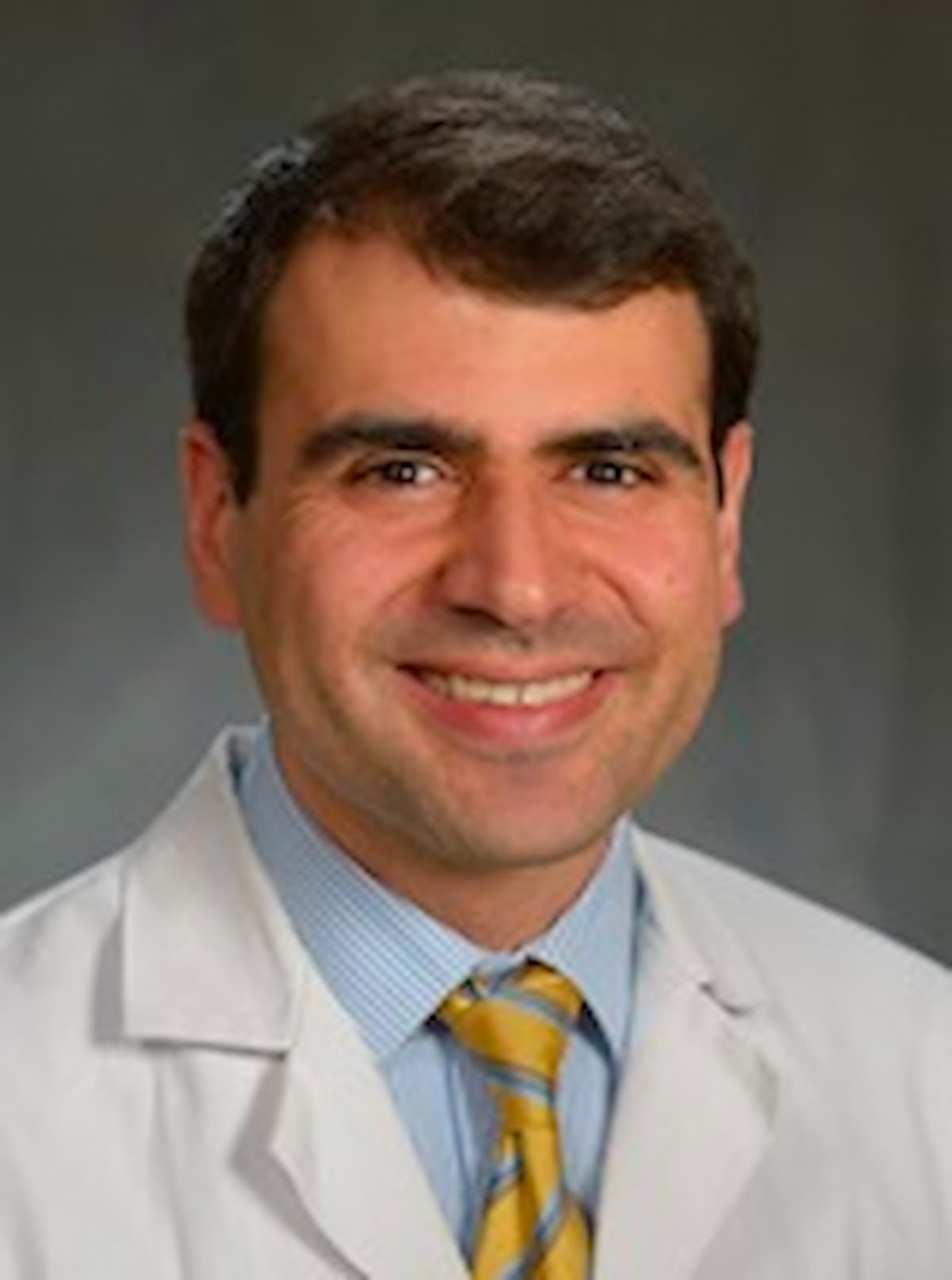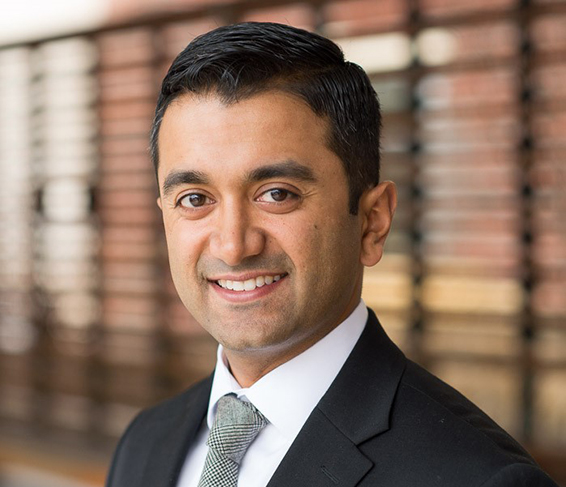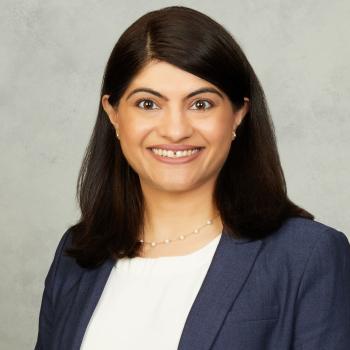ASH Top Takeaways of Bispecific Antibodies in R/R Multiple Myeloma
Hematologists gathered to discuss recent updates on bispecific antibodies surrounding patients with relapsed/refractory multiple myeloma.
Alfred L. Garfall, MD, Director of Autologous Hematopoietic Stem Cell Transplantation, Section Chief of Myeloma, and Associate Professor, Hematologic Oncology, University of Pennsylvania

Omar Nadeem, MD, Clinical Director of Myeloma Immune Effector Cell Therapy Program, Clinical Director at the Center for Early Detection and Interception of Blood Cancer, Associate Director of Multiple Myeloma Clinical Research Program, and Senior Physician at Dana-Farber Cancer Institute, and Assistant Professor of Medicine, Harvard Medical School

Naresh Bumma, MD, Assistant Professor, Division of Hematology, Ohio State University Comprehensive Cancer Center- The James

Surbhi Sidana, MD, Associate Professor, Blood and Marrow Transplantation and Cellular Therapy, Clinical Research Group Co-Leader for BMT/Cell Therapy, Stanford Cancer Institute

As part of an Around the Practice® program, CancerNetwork® hosted a panel discussion during the 66th American Society of Hematology Annual Meeting focused on bispecific antibodies for the treatment of relapsed/refractory multiple myeloma. The program was brought together to discuss how the therapeutic landscape has evolved, as well as ongoing unmet needs and challenges for this patient population. The panel also discussed the long-term efficacy of talquetamab-tgvs (Talvey) in this patient population, with a discussion surrounding a comparative analysis of the agent with physician’s choice of therapy following. Furthermore, the efficacy and safety of teclistamab-cqyv (Tecvayli) and elranatamab-bcmm (Elrexfio) were assessed, followed by a discussion regarding patient benefit with each bispecific.
The panel was led by Alfred L. Garfall, MD, director of Autologous Hematopoietic Stem Cell Transplantation, section chief of Myeloma, and associate professor, Hematologic Oncology, University of Pennsylvania. Panelists included Omar Nadeem, MD, clinical director of the Myeloma Immune Effector Cell Therapy Program, clinical director at the Center for Early Detection and Interception of Blood Cancer, associate director of Multiple Myeloma Clinical Research Program, and senior physician at Dana-Farber Cancer Institute, and assistant professor of medicine, Harvard Medical School; Naresh Bumma, MD, assistant professor in the division of Hematology, Ohio State University Comprehensive Cancer Center- The James; and Surbhi Sidana, MD, associate professor of Blood and Marrow Transplantation and Cellular Therapy at Stanford Cancer Institute.
Outlining the Safety Profile and Efficacy of Talquetamab in R/R MM
Garfall: In the last couple years, 3 different bispecific antibodies [were] approved for the treatment of relapsed/refractory multiple myeloma. We [will] talk about results from long term follow up from some of the initial agents.
Nadeem: We have the updated [results presented at the] International Myeloma Society [IMS] annual meeting with talquetamab, a GPRC5D bispecific targeting antibody that has been approved based on the phase 1/2 MonumenTAL-1 trial (NCT03399799; NCT04634552).1 There were 3 different cohorts in the study looking at 2 [dose levels], at 0.4 mg/kg every week or 0.8 mg/kg every 2 weeks. Both of those arms showed good efficacy, so the response rates were around 70%, and the durability of response with longer follow-up we are starting to see pan out.
If you look at the 0.8 mg/kg every 2 weeks group, the median progression-free survival [PFS] is now about 1 year. It is slightly less in the 0.4 mg/kg weekly dose group and slightly less for the third cohort, which had patients who took prior T-cell redirecting therapy. The response rates in these cohorts were around 70% which is impressive. [It was] a heavily pre-treated patient population, so it is great to see the data mature, and we did not see any new safety signals.
Garfall: One of the most exciting things about the study was the response [rate] in patients who have had prior T-cell redirecting therapy. To see those high response rates in that group of patients who had either prior B-cell maturation antigen (BCMA) CAR T-cell or prior BCMA bispecific therapy. They seem to be holding up well with long term follow.
Talquetamab has a distinct toxicity profile compared with the BCMA directed agents. We learned about how that is holding up over long term follow up in [the talquetamab results], but maybe we could talk about what our personal experiences are using this agent in patients, especially those long-term responders in our practices.
Nadeem: Taste changes occurred in about 70% of patients, but it does seem to resolve over time. [For taste changes] dose and schedule modifications do the trick. Skin changes and nail bed changes are seen––weight loss is seen in about 40% of patients. All that data we already knew, but with longer-term follow-up, we did not see any increase of some of those toxicities. Despite that, the discontinuation rate is not high with talquetamab, and that speaks to the adjustments that we can now make. What we are doing now in real-world practice is de-escalating therapy for patients who have had a great response, who are experiencing some of these toxicities, and moving to a less frequent schedule.
Garfall: There is a lot of weight loss early on, and maybe it does not completely recover, but it does start to moderate over time. Does that fit with how you have seen it in your practice?
Bumma: I would say it is similar. One patient [is a chef who] makes Italian food. She used to tell me, she could not taste the sauce she used to make, and she had to hire someone to make her sauce. Once we got a [favorable] response, we de-escalated [treatment], and her taste has gotten much better. She cannot taste as well as she used to, but she is doing better. I do believe that, along with the taste, the weight part is a fairly good marker to measure.
Sidana: We prepare our patients so well––they understand to expect it. After a couple of months of trial and error, they all figure out a few foods that work for them. After a while, their weight becomes steady.
Garfall: The rate of discontinuation [due to adverse effects (AEs)] is low. That speaks to the tolerability, even though it can be burdensome for patients.
Comparing the Efficacy of Talquetamab Vs Physician’s Choice in R/R MM
Garfall: Let’s move on to the next abstract that we wanted to discuss, which was a real-world comparison of talquetamab vs a real-world physician's choice in that line of therapy.2 Do you have any thoughts on that abstract?
Bumma: One of the limitations of the trial is how it translated to the real world. There are some statistical issues, but it is an important thing that they did [this analysis]. What I find interesting is that the biweekly dose in this analysis [did] better than the weekly dose. In the final analysis, the once-weekly dose was 32.1 months vs 16.5 months, and the twice-weekly dose was not reached vs 15.8 months. That makes me feel more vindicated about using the biweekly dosing.
It gives us a good signal that this would take over some of the spots, but also, that these are [adverse] effects that we were not used to in the myeloma world, and now that we are used to them, we become more comfortable [with them]. We should be able to overcome that hesitancy to use this drug because of unusual [adverse] effects and not deprive patients of adequate therapies.
Sidana: One thing I would like to add is, with talquetamab especially, we see that in high-risk subgroups... the EMDs, the high-risk cytogenetics, the response rate, and the durability appears to be comparable, especially in the late relapse setting. That is critical, because these patients are so hard to treat.
Identifying Talquetamab Eligibility for Patients with R/R MM
Garfall: It is worth thinking for a second about how we are using talquetamab in our practices where we have other bispecific antibodies. We are practicing at centers where CAR T cells are available but also centers where patients maybe come from far away as consultations, and where they want to be treated in the community. What patients [are] you giving talquetamab to in your practices?
Nadeem: Most of the time, it is patients who have had a prior BCMA-directed agent, [mostly] CAR T cells. That is preferred for patients that are eligible and able to receive it. At the time of relapse, talquetamab fits in nicely. Those patients have been removed from T cell therapies. typically for over a year in many circumstances. That is where it fits in most commonly.
In patients that are not CAR T cell eligible, and they have not had a T cell redirecting therapy, talquetamab plus the other BCMA bispecifics are both a great option. You then [decide] based on the patient factors and preferences. If not used [after a prior BCMA-directed agent], then it tends to be used at the time of relapse, whichever agent is chosen first.
Sidana: Practice is biased towards CAR T for patients who are eligible, but some patients are not eligible, and some patients do not want to go through the logistics of that. For those patients, both options are there. Sometimes when someone has extra medullary disease, and we are going to use 1 bispecific and not an off-label combination, then I might prefer talquetamab first in the patients with extramedullary disease [EMD] who are T cell engager or T cell therapy naïve, but post-CAR T [or] BCMA relapse. Especially if it is earlier onset relapse, using talquetamab is the next go-to step.
One place we are also using it is bridging, because sometimes for patients who want to get to CAR T, the manufacturing time can take a couple of months after apheresis. Talquetamab is a wonderful drug in my experience, to bridge and bring the disease burden down. We are presenting data from our shared experience at ASH, where the response rates are great, and it does not affect the CAR T toxicity. That is a great bridge as well.
Discussing Teclistamab Use in R/R MM
Garfall: The long term follow-up of the MajesTEC-1 trial (NCT03145181/NCT04557098) .... led to the approval of teclistamab.3 How has long term use of teclistamab been in your practices now?
Nadeem: We have a lot of experience with it, and [we are comfortable] with the step-up dosing and management of the more initial toxicities and mitigation strategies for infection with reduced frequency dosing. Per label we can go to every 2 weeks for patients that are in response beyond 6 months. In our practices, we are going either to that earlier, or reducing it further, depending on what their response status is. The use of intravenous immunoglobulin [IVIG] has been helpful in reducing some of these infections that we have seen. All that has made it a commonly used agent in all our practices.
Sidana: When we started using teclistamab, it was the first [approved] BCMA bispecific. We did not know about antibiotic prophylaxis, antiviral prophylaxis, or IVIG. We had to learn on the go while the COVID pandemic was happening. Since then, aggressive IVIG, aggressive antibiotic prophylaxis, and infections can still happen, but they are manageable, and they are not [usually] severe in my experience.
Bumma: We are getting more comfortable [and great responses] with this medication. Five to 10 years ago, if you told somebody a single agent drug [would elicit] 24-month [median overall survival], they would ask, which miracle drug is this? We just hit 24 months, and none of us batted an eyelash, because we are so used to it.
Assessing Elranatamab Against Teclistamab in R/R MM
Nadeem: The median follow up was [28.4 months] for the phase 2 MagnestisMM-3 trial (NCT04649359) ... [De-escalation was] built into the trial.4 With longer follow up, despite less dosing [volume] or less frequent dosing, patients maintained their response. The overall response rate was [61.0%] which is [similar to] the previous update, and the median PFS was [17.2 months]. That is showing good durability of response despite less frequent dosing, and that helps mitigate some of the [AEs] that we see with these agents.
Garfall: In your practice, have you used much elranatamab?
Nadeem: [Teclistamab] has been our most commonly used BCMA bispecific agent, but we are starting to see more patients receive elranatamab as well. Right now, it is difficult to compare 2 products that have not been compared in head-to-head in clinical trials. Broadly speaking, they are similar in terms of their overall efficacy.
The dosing can be a bit different––the step-up dosing is different, which is important to highlight ... For those that are doing inpatient, step up dosing [can still] matter. The patient does not have to be in for a full week. Those are some differences.
References
- Ye JC, Schinke C, Touzeau C, et al. Long-term efficacy and safety results from the phase 1/2 MonumenTAL-1 study of talquetamab, a GPRC5D×CD3 bispecific antibody, in patients with relapsed/refractory multiple myeloma. Presented at the 21st International Myeloma Society (IMS) Annual Meeting; September 25-28, 2024. Rio De Janeiro, Brazil. Abstract P-098
- Ye JC, Biran N, Nair S, et al. Updated comparative effectiveness of talquetamab vs real-world physician’s choice of treatment in patients with triple-class exposed relapsed/refractory multiple myeloma. Presented at the 21st International Myeloma Society (IMS) Annual Meeting; September 25-28, 2024. Rio De Janeiro, Brazil. Abstract P-099
- Garfall AL, Nooka AK, van de Donk NWCJ, et al. Long-term follow-up from the phase 1/2 MajesTEC-1 trial of teclistamab in patients with relapsed/refractory multiple myeloma. J Clin Oncol. 2024;42(suppl 16). Abstract 7540. doi:10.1200/JCO.2024.42.16_suppl.7540
- Prince HM, Bahlis NJ, Rodríguez-Otero P, et al. MagnetisMM-3: Long-term update and efficacy and safety of less frequent dosing of elranatamab in patients with relapsed or refractory multiple myeloma. Blood. 2024;144(suppl 1). Abstract 4738. doi:10.1182/blood-2024-208192
Newsletter
Stay up to date on recent advances in the multidisciplinary approach to cancer.